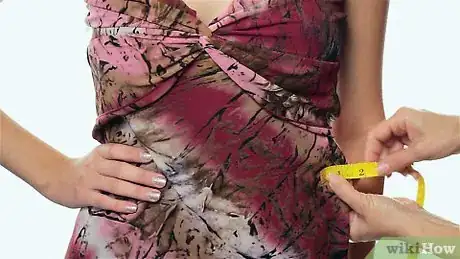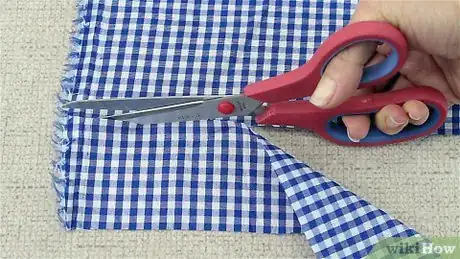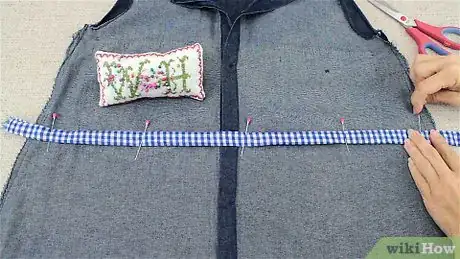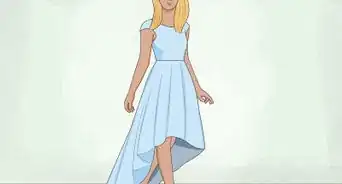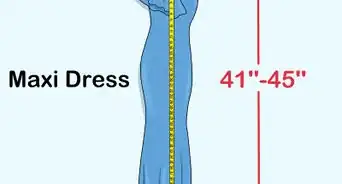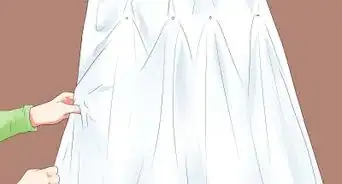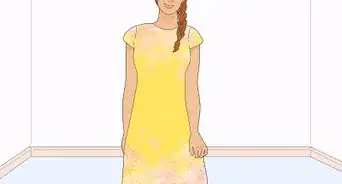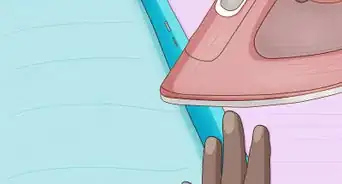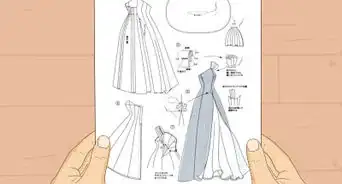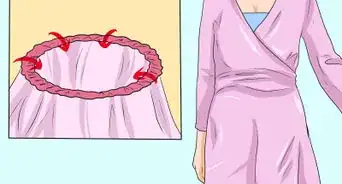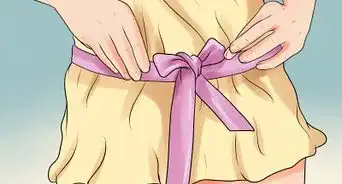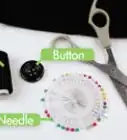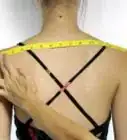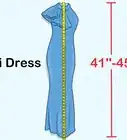This article was co-authored by Essie Karimi and by wikiHow staff writer, Jessica Gibson. Essie Karimi is a Professional Tailor and the Owner of Sew Fit Tailoring & Alterations, a sewing shop that has been operating for over 40 years. Essie specializes in tailoring, alterations, sewing, repairs, and redesign. Essie works on a variety of clothing types, including wedding dresses, formal wear, casual wear, sportswear, swimwear, and uniforms.
There are 7 references cited in this article, which can be found at the bottom of the page.
wikiHow marks an article as reader-approved once it receives enough positive feedback. In this case, several readers have written to tell us that this article was helpful to them, earning it our reader-approved status.
This article has been viewed 462,618 times.
Don't throw out the baggy dress that's been hiding in the back of your closet! Take in the waist to improve the fit and you'll feel like you've got a brand new dress. You can pin excess fabric along the side seams down to the waist. This will prevent puckering when you sew the new seams. If you're taking in a dress with a looser style, sew a fabric casing onto the waist instead. Then, push an elastic band through the casing so it gathers at the waist.
Steps
Taking in the Waist at the Sides
-
1Pinch the waist of the dress to determine how much to take in. Put on the dress like you normally would so you have a good idea of how it currently fits and how you'd like it to fit. Then, pinch both sides of your waist at the narrowest part until the waist is as tight as you like. Hold a ruler across the fabric you're pinching in order to see out how much fabric to take in.[1]
- To keep the waist even, you'll need to take in the same amount of fabric from each side seam.
- For example, you might want to take in a dress by 1⁄2 inch (1.3 cm) on each side so it fits better.
-
2Turn the dress inside out and insert pins along the seamline. Lay the inside out dress on a flat surface and locate the top of the side seams where they meet the armhole. Then, place your ruler on the dress and insert pins so they lie in the direction of the seam. Measure the excess fabric from the newly pinned seamline to the old seam. It should match the measurement you took.
- Pin about every 1 inch (2.5 cm) or so all the way down to the narrowest part of the waist.
- Ensure that each pin goes through both sides of the dress.
Advertisement -
3Try on the dress and adjust the pins if needed. Before you begin cutting or sewing the dress, put it back on while it's inside out. The waist should fit the way you like since you've pinned the excess fabric.
- If the waist is still too loose, adjust the pins to take in more fabric. If the dress feels too tight, consider letting out some of the fabric at the waist.
-
4Remove the dress and mark each side seam from the armhole to the waist. Once you're happy with how the pinned dress fits, take it off and lay it on your work surface. Use a piece of fabric chalk to draw along the line of pins. This will mark the new seam. Try to match the current curve of the seam line.[2]
- Taking in the side seams to the waist will prevent the waist from puckering when you remove the excess fabric.
-
5Sew a straight stitch along the seam lines you marked. Use your sewing machine loaded with thread that matches the dress to stitch the new seam line on each side of the dress. Remove the pins as you work so they don't get caught in your machine.[3]
- Although you could take in the dress by hand, a sewing machine will make stronger, more uniform stitches.
Tip: If you're taking in a lined dress, snip the lining where it's attached to the fabric of the dress. Once you've sewn the new seam on the fabric of the dress, take in the same amount from the lining. Then, reattach the lining to the inside of the dress.
-
6Turn the dress right side out and try it on. If you like the way the waist fits, your dress is ready to wear! If you're bothered by the excess fabric inside the dress, you can cut away the excess from the seam lines so there's 1⁄4 inch (0.64 cm) allowance.[4]
- Read the care label for the dress to see if you should iron it. This can give your dress a more polished look.
Cinching the Waist with an Elastic Band
-
1Try on an inside-out dress and wrap a narrow belt around the waist. Take the dress you want to alter and turn it inside out. Put on the inside-out dress along with a thin belt. Tighten the belt so it sits comfortably on the narrowest part of your waist.[5]
- Place the belt where you'd like the elastic casing to be.
Tip: Adding an elastic waist works best for loose or baggy dresses with lightweight fabrics that drape, such as rayon, linen, and cotton.
-
2Mark around the waistline with fabric chalk. Take the chalk and draw a line around the waist where the belt lies. If it's easier, you could make several marks or insert sewing pins across the waist. Then, take the dress off and use a measuring tape to draw a straight line connecting the marks or pins.[6]
- Since it can be hard to reach around, you may want to ask a friend to help you with this step.
- The fabric chalk should dissolve when you wash the dress.
-
3Lay the dress on a table and measure the waistline circumference. Keep the dress turned inside out and lay it flat on a table. Take a measuring tape and pull it around the waistline you marked so you can find the circumference for the dress.[7]
- It's important to use your own measurement instead of relying on size charts. Size charts that pair waist measurements with sizes can vary wildly.
-
4Cut a strip of fabric that's 1 inch (2.5 cm) longer than the circumference. Lay about 2 to 4 feet (0.61 to 1.22 m) of fabric that matches your dress on a work surface. Then, cut the fabric to a 1 3⁄4 in (4.4 cm) wide strip that's 1 inch (2.5 cm) longer than the measurement for the waistline circumference.[8]
- For example, if your waistline measured 38 inches (97 cm), cut the strip 39 inches (99 cm) long and 1 3⁄4 in (4.4 cm) wide.
-
5Fold the strip lengthwise and sew 1⁄4 inch (0.64 cm) along the edge. Fold the fabric in half lengthwise so the right sides are facing together. Then, take it to your sewing machine and straight stitch along the long edge of the fabric. Leave a 1⁄4 inch (0.64 cm) seam allowance. Stop sewing when you're about 2 inches (5.1 cm) from the end of the strip.
- To make it easier to sew, consider ironing the strip of fabric so it stays flat.
- You should now have a casing that looks like a long, thin tube.
-
6Hook a safety pin to 1 end of the casing and pull the casing right side out. The fabric might twist or get stuck if you try to turn the casing right side out. To prevent this, secure a safety pin to 1 end of the casing and push it through that end until it comes out the other end. The casing should now be right side out.[9]
- If you'd like the casing to lie flat, you can iron it once it's right side out.
- You can remove the safety pin once you've turned the casing right side out.
-
7Pin the casing just below the waistline you marked on the dress. Wrap the casing you just made right below the line you marked on the dress. Line up the ends of the casing with a seam that's on the inside-out dress. Depending on your dress, you could line it up with a side seam or a seam that runs down the back of the dress. Then, secure the casing with sewing pins.[10]
- Try to pin every 1 to 2 inches (2.5 to 5.1 cm) so the casing doesn't slide around.
-
8Edge stitch the bottom and top of the casing to the waistline. You can use your regular presser foot to edge stitch 1⁄8 inch (0.32 cm) from the top and bottom edges of the casing. Stitch around the waistline, but stop about 2 inches (5.1 cm) from the end so you can feed the elastic through the casing.[11]
- If your machine has one, use an edge joining foot. This foot will act as a guide as you edge stitch along the casing.
-
9Cut a piece of elastic 1 inch (2.5 cm) longer than the waistline. Get out a 1⁄4 inch (0.64 cm) wide piece of elastic and unroll it so it's as long as your waistline measurement. Add 1 inch (2.5 cm) to the measurement and cut the elastic.[12]
-
10Secure a safety pin to the elastic and pull it through the casing. The safety pin will make it easier to pull the elastic through the casing. Keep pulling the pin until the elastic is completely through the casing.[13]
- To prevent the elastic from slipping back into the casing, you can pin the ends to the fabric outside the casing.
- At this point you can try on the dress right side out to see if you're happy with the waistline.
-
11Zigzag stitch the ends of the elastic together and sew the casing shut. Once you've taken the safety pin out, overlap the ends by 1 inch (2.5 cm). Then, zigzag stitch the ends together and use a straight stitch to sew the casing closed. You can now turn the dress right side out and enjoy the tighter waist![14]
Expert Q&A
-
QuestionWhat is the purpose of pinning fabric?
 Essie KarimiEssie Karimi is a Professional Tailor and the Owner of Sew Fit Tailoring & Alterations, a sewing shop that has been operating for over 40 years. Essie specializes in tailoring, alterations, sewing, repairs, and redesign. Essie works on a variety of clothing types, including wedding dresses, formal wear, casual wear, sportswear, swimwear, and uniforms.
Essie KarimiEssie Karimi is a Professional Tailor and the Owner of Sew Fit Tailoring & Alterations, a sewing shop that has been operating for over 40 years. Essie specializes in tailoring, alterations, sewing, repairs, and redesign. Essie works on a variety of clothing types, including wedding dresses, formal wear, casual wear, sportswear, swimwear, and uniforms.
Professional Tailor Pinning allows you to see how much fabric you need to take in, as well as how the dress will fit once it's taken in or sewn.
Pinning allows you to see how much fabric you need to take in, as well as how the dress will fit once it's taken in or sewn. -
QuestionHow do you take in the sides of a dress without a sewing machine?
 Essie KarimiEssie Karimi is a Professional Tailor and the Owner of Sew Fit Tailoring & Alterations, a sewing shop that has been operating for over 40 years. Essie specializes in tailoring, alterations, sewing, repairs, and redesign. Essie works on a variety of clothing types, including wedding dresses, formal wear, casual wear, sportswear, swimwear, and uniforms.
Essie KarimiEssie Karimi is a Professional Tailor and the Owner of Sew Fit Tailoring & Alterations, a sewing shop that has been operating for over 40 years. Essie specializes in tailoring, alterations, sewing, repairs, and redesign. Essie works on a variety of clothing types, including wedding dresses, formal wear, casual wear, sportswear, swimwear, and uniforms.
Professional Tailor Try temporarily pinning the fabric in place or adding some small stitches to the dress by hand.
Try temporarily pinning the fabric in place or adding some small stitches to the dress by hand. -
QuestionIs there a way I can take in a dress without sewing it?
 Community AnswerYou could try fusible tape, but this would be a temporary solution.
Community AnswerYou could try fusible tape, but this would be a temporary solution.
Things You'll Need
Taking in the Waist at the Sides
- Dress
- Fabric chalk
- Sewing machine
- Thread
- Ruler
- Measuring tape
- Sewing pins
Cinching the Waist with an Elastic Band
- Dress
- Narrow belt
- Sewing pins
- Sewing machine
- Thread
- Scissors
- 1⁄4 inch (0.64 cm) elastic
- Fabric that matches the dress
- Fabric chalk
- Measuring tape
- Iron and ironing board, optional
References
- ↑ https://youtu.be/hB-M6zRdXhU?t=38
- ↑ https://youtu.be/hB-M6zRdXhU?t=74
- ↑ https://youtu.be/hB-M6zRdXhU?t=94
- ↑ https://youtu.be/hB-M6zRdXhU?t=121
- ↑ https://www.threadsmagazine.com/2017/02/06/cinch-a-dress-with-an-elastic-waist
- ↑ https://www.threadsmagazine.com/2017/02/06/cinch-a-dress-with-an-elastic-waist
- ↑ https://www.threadsmagazine.com/2017/02/06/cinch-a-dress-with-an-elastic-waist
- ↑ https://www.threadsmagazine.com/2017/02/06/cinch-a-dress-with-an-elastic-waist
- ↑ https://www.fabric.com/blog/sewing-101-elastic-waistbands/
- ↑ https://www.threadsmagazine.com/2017/02/06/cinch-a-dress-with-an-elastic-waist
- ↑ https://sewguide.com/edge-stitch/
- ↑ https://www.fabric.com/blog/sewing-101-elastic-waistbands/
- ↑ https://www.fabric.com/blog/sewing-101-elastic-waistbands/
- ↑ https://www.threadsmagazine.com/2017/02/06/cinch-a-dress-with-an-elastic-waist
About This Article
The easiest way to take in a dress at the waist is to put the dress on inside out and pin the waist where you want to take it in. Take the dress off carefully and mark the pinned area with chalk. Remove the pins, sew along the chalk line, then turn the dress right side out. Read on for more details about how to cut away excess fabric!
